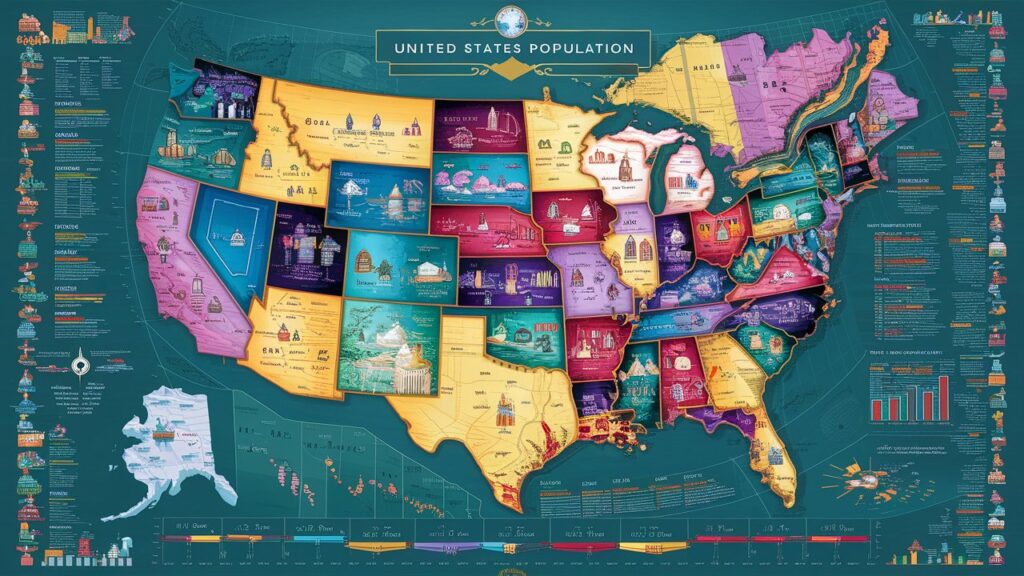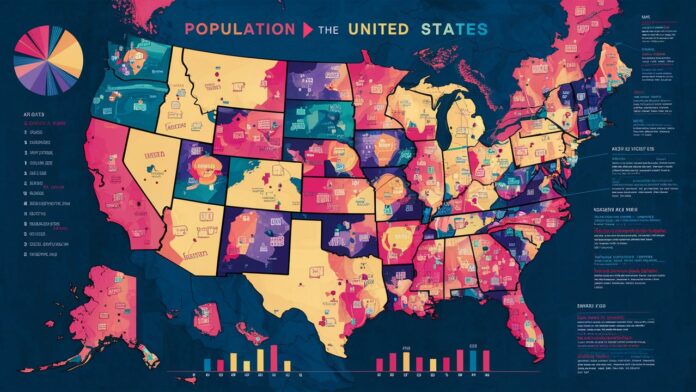Introduction
The United States stands as a demographic powerhouse, ranking as the third-most populous nation globally after India and China. As of mid-2025, America’s population reaches an estimated 347.3 million people, accounting for approximately 4.22% of the world’s inhabitants 214. This figure represents more than a quadrupling since 1900 when only 76.2 million people called the U.S. home 815. Understanding America’s population involves examining its growth trajectories, demographic shifts, geographic distribution, and future projections. These metrics illuminate critical trends in urbanization, aging, diversity, and economic resilience that will shape the nation’s social and policy landscapes for decades to come.
Current Population Snapshot (2025)
In 2025, the U.S. population reaches 347,275,807 at mid-year, reflecting a modest annual growth rate of 0.54% 214. This translates to roughly 1.85 million people added yearly. Behind this growth lies a pivotal demographic shift: Net international migration now drives expansion more than natural increase (births minus deaths). In 2025 alone, net migration contributes 1.23 million people, outpacing natural increase for the first time in decades 28. Population density remains relatively low at 38 people per square kilometer (98 per square mile), distributed unevenly across the country’s vast 9.15 million km² land area 2. Urbanization continues to dominate, with 82.8% of residents living in cities—totaling over 287 million urban dwellers 26.
Historical Growth Trends
The 20th century witnessed explosive U.S. population growth:
- 1900: 76.2 million 15
- 2000: 281.5 million 8
- 2025: 347.3 million 2
Post-World War II baby booms saw growth rates exceeding 1.6% annually in the 1950s–1960s, fueled by high fertility (peaking at 3.73 children per woman in 1960) and robust immigration 212. Growth rates have since halved, falling to 0.54% by 2025 due to declining birth rates (1.62 children per woman) and aging demographics 28. Key legislative changes, like the 1965 Immigration and Nationality Act, reshaped inflows, with immigrants rising from 9.6 million (1970) to over 45 million (2015) 8.
Demographic Composition
Race and Ethnicity
The U.S. is rapidly diversifying:
- Non-Hispanic Whites: 57.8% (2020), projected to drop below 48% by 2055 68
- Hispanics: 23% growth (2010–2020), now constituting 18.9% of the population and driving over half of recent growth 68
- Asian Americans: Fastest-growing group (+35% since 2010), especially multiracial Asians (+55%) 8
- Foreign-born residents: Represent 14% of the population (up from 5% in 1965), projected to hit 19% by 2060 6
Age Structure
An aging populace presents societal challenges:
- Median age: 38.5 years (up from 28.3 in 1960) 2
- 65+ population: 17.7% (2024), expected to approach 24% by 2060 78
- Dependency ratio: 49.7%, comprising 30.1% child dependents and 19.7% aged dependents 7
Table: U.S. Population Age Structure (2025)
| Age Group | Percentage | Key Implications |
| Under 15 | 20.1% | Future workforce |
| 15–64 years | 66.8% | Current labor force |
| 65+ years | 13.1% | Rising healthcare/retirement needs |
| Source: Derived from UN data 7 |
Geographic Distribution and Urbanization

Population density varies dramatically:
- Coastal and metro dominance: Over 80% of Americans live in urban corridors (e.g., Northeast, California, Great Lakes) 2
- Rural decline: Non-metro areas face depopulation, impacting infrastructure and services
- Largest states: California (39M), Texas (30M), Florida (22M) 15
Urbanization accelerated from 73.7% in 1975 to 82.8% in 2025, with cities like New York, Los Angeles, and Chicago magnetizing domestic and international migrants 26. This concentration fuels economic productivity but strains housing, transportation, and environmental resources.
Global Context
Globally, the U.S. ranks:
- #3 in population after India (1.46 billion) and China (1.42 billion) 14
- #10 in population density among large nations (38/km² vs. India’s 492/km²) 14
- #3 in net migration, attracting over 1.23 million migrants annually—more than any nation except UAE and Germany 214
America’s demographic influence remains outsized due to immigration magnetism and its role as the largest economy. By 2050, however, its global population share will dip to 3.98% as Africa and Asia grow faster 214.
Future Projections: 2025–2050
The Census Bureau and UN project:
- 2030: 355.6 million
- 2040: 370.2 million
- 2050: 380.8 million 2
Growth will slow to 0.25% annually by 2050, with net migration increasingly offsetting low fertility 2. Key implications include:
- Aging intensifying: Median age rising to 41.2 by 2045, straining Social Security and healthcare 2
- Diversity deepening: “Majority-minority” status likely by 2043 8
- Economic shifts: A shrinking working-age cohort supporting more retirees, raising dependency challenges 7
Conclusion
The U.S. population story is one of dynamic transformation: from explosive 20th-century growth to today’s migration-driven, diversifying, and graying society. By 2025, America’s 347 million residents reflect a nation where immigrants propel expansion, cities dominate landscapes, and aging reshapes social contracts. Looking ahead, managing healthcare, labor markets, and infrastructure will require policies attuned to these irreversible trends. While growth slows, America’s demographic vitality—fueled by its unique appeal to global talent—ensures its continued prominence on the world stage.
Frequently Asked Questions (FAQs)
How many people live in the U.S. in 2025?
The U.S. population is 347,275,807 as of mid-2025, per United Nations data 214.
What is the U.S. population growth rate?
The 2025 growth rate is 0.54%, adding 1.85 million people yearly. This is down from >1% rates in the late 20th century 212.
Where does the U.S. rank globally by population?
The U.S. is third, behind India (1.46 billion) and China (1.42 billion) 14.
How urbanized is America?
82.8% of Americans live in urban areas—totaling 287 million people 26.
What drives U.S. population growth?
Since 2021, net migration (1.23 million/year) has surpassed natural increase (births minus deaths) as the primary driver 28.
How diverse is the U.S. population?
No single racial/ethnic group holds a majority in many states. Hispanics and Asians are the fastest-growing groups, while non-Hispanic whites decline to <48% by 2055 68.
What will the U.S. population be in 2050?
Projections estimate 380.8 million by 2050, growing slower annually (0.25%) due to aging and lower fertility 2.

